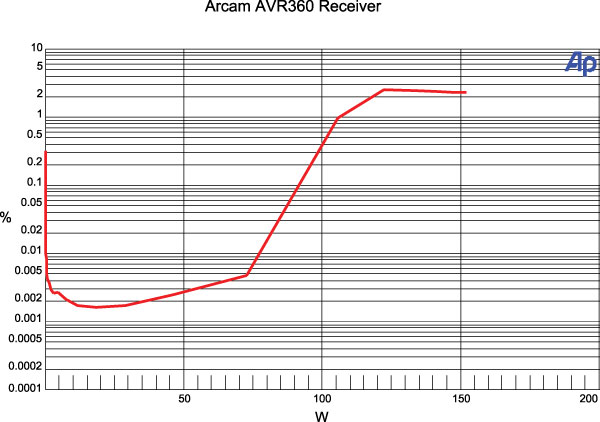Arcam AVR360 A/V Receiver HT Labs Measures
Two channels driven continuously into 8-ohm loads:
0.1% distortion at 91.5 watts
1% distortion at 105.9 watts
Five channels driven continuously into 8-ohm loads:
0.1% distortion at 82.6 watts
1% distortion at 90.2 watts
Seven channels driven continuously into 8-ohm loads:
0.1% distortion at 61.3 watts
1% distortion at 71.0 watts
Analog frequency response in Stereo Direct mode:
–0.06 dB at 10 Hz
–0.01 dB at 20 Hz
+0.01 dB at 20 kHz
–2.73 dB at 50 kHz.
Analog frequency response with stereo signal processing:
–1.28 dB at 10 Hz
–0.38 dB at 20 Hz
–0.18 dB at 20 kHz
–13.45 dB at 50 kHz.

This graph shows that the AVR360’s left channel, from CD input to speaker output with two channels driving 8-ohm loads, reaches 0.1 percent distortion at 91.5 watts and 1 percent distortion at 105.9 watts. Into 4 ohms, the amplifier reaches 0.1 percent distortion at 136.5 watts and 1 percent distortion at 152.9 watts.
Response from the multichannel input to the speaker output measures –0.06 dB at 10 Hz, –0.01 dB at 20 Hz, –0.07 dB at 20 kHz, and –2.91 dB at 50 kHz. THD+N from the CD input to the speaker output was less than 0.003 percent at 1 kHz when driving 2.83 volts into an 8-ohm load. Crosstalk at 1 kHz driving 2.83 volts into an 8-ohm load was –80.14 dB left to right and –84.32 dB right to left. The signal-to-noise ratio with an 8-ohm load from 10 Hz to 24 kHz with “A” weighting was –110.66 dBrA.
From the Dolby Digital input to the loudspeaker output, the left channel measures –0.01 dB at 20 Hz and –0.12 dB at 20 kHz. The center channel measures –0.01 dB at 20 Hz and –0.19 dB at 20 kHz, and the left surround channel measures –0.01 dB at 20 Hz and –0.14 dB at 20 kHz. From the Dolby Digital input to the line-level output, the LFE channel is +0.01 dB at 20 Hz when referenced to the level at 40 Hz and reaches the upper 3-dB down point at 109 Hz and the upper 6-dB down point at 116 Hz.—MJP

Video Test Bench
The Arcam AVR360’s video processing was disappointing. The 2:2 HD failures are relatively common among the A/V receivers we have tested, but the 3:2 failures are not. The Arcam also failed the video clipping test when processing was engaged by not passing information below a video level of 20 (video black is a level of 16). It also went only 2 percent above video white (to a level of 240—video white is 235), and while this would be passing, it’s borderline acceptable. The levels for our 8-bit video system comprise steps from 0 to 255. For video, only levels from 16 to 235 are used, with the remainder providing foot room and headroom. While response below black is useful mainly to set black level properly (once set, you will not see anything below black), response above white is needed to avoid clipping from sources that contain information above 235. While technically they should not, many do. Setting the AVR to bypass the upscaling eliminates the clipping, and would allow a source component or display to perform this function. —TJN





























































